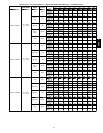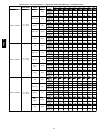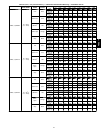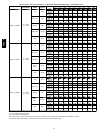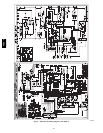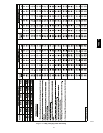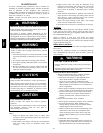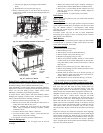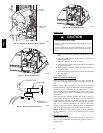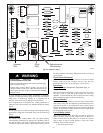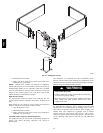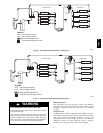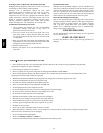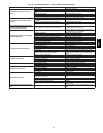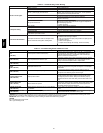
29
f. Connect 5 pin plug and 4 pin plug to indoor blower
motor.
g. Reinstall blower access panel (see Fig. 19).
3. Restore electrical power to unit. Start unit and check for
proper blower rotation and motor speeds during heating and
cooling cycles.
Integrated
Gas Unit
Controller
(IGC)
Induced Draft
Motor
Rollout
Switch
Mounting
Screw
Burner
Rack
Inducer
Blower
Housing
Flue
Collector
Box
Interface Fan
Board (IFB)
Auto Transformer
fuses used on 460
volt units only.
(Hidden)
Fan Partition
Mounting
Bracket
A09193
Fig. 18 -- Blower Housing and Flue Collector Box
COMPRESSOR
ACCESS PANEL
BLOWER
ACCESS
PANEL
CONTROL
ACCESS
PANEL
A09207
Fig. 19 -- Unit Access Panels
Induced Draft (combustion air) Blower Assembly
The induced--draft blower assembly consists of the inducer motor,
the blower housing, and the induced--draft blower wheel.
Clean periodically to assure proper airflow and heating efficiency.
Inspect blower wheel every fall and periodically during the heating
season. For the first heating season, inspect blower wheel
bimonthly to determine proper cleaning frequency.
To inspect blower wheel, remove draft hood assembly. Shine a
flashlight into opening to inspect wheel. If cleaning is required,
remove induced--draft blower assembly as follows:
1. Remove control access panel (See Fig. 19).
2. Remove the 5 screws that attach induced--draft blower as-
sembly to the flue collector box cover.
3. Slide the assembly out of the unit. (See 20). Clean the
blower wheel. If additional cleaning is required, continue
with Steps 4 and 5.
4. To remove blower wheel, remove 2 setscrews.
5. To remove inducer motor, remove screws that hold the
inducer motor to the blower housing.
6. To reinstall, reverse the procedure outlined above.
Flue Gas Passageways
To inspect the flue collector box and upper areas of the heat
exchanger:
1. Remove the induced draft blower assembly according to
directions in the Induced Draft Blower Assembly section.
2. Remove the 11 screws holding the flue collector box cover
(See Fig. 18) to the heat exchanger assembly. Inspect the
heat exchangers.
3. Clean all surfaces, as required, using a wire brush.
Limit Switch
Remove blower access panel (see Fig. 19). Limit switch is located
on the fan partition.
Burner Ignition
Unit is equipped with a direct spark ignition 100 percent lockout
system. Ignition module (IGC) is located in the control box (See
Fig. 18). Module contains a self--diagnostic LED. During
servicing, refer to label diagram or Table 5 in these instructions for
LED interpretation.
If lockout occurs, unit may be reset by either momentarily
interrupting power supply to unit or by turning selector switch to
OFF position at the thermostat.
Main Burners
At the beginning of each heating season, inspect for deterioration
or blockage due to corrosion or other causes. Observe the main
burner flames and adjust, if necessary.
Removal of Gas T
rain
To remove the gas train for servicing:
1. Shut off main gas valve.
2. Shut off power to unit and install lockout tag.
3. Remove control access panel (See Fig. 19).
4. Disconnect gas piping at unit gas valve.
5. Remove fan partition mounting bracket (2 screws located
on the left side of the control compartment on the fan parti-
tion panel). Slide bracket forward, bottom first, to remove
(See Fig. 18).
6. Remove wires connected to gas valve. Mark each wire.
7. Remove the mounting screw that attaches the burner rack to
the unit base (See Fig. 18).
8. Partially slide the burner rack out of the unit (see Fig. 18
and 21). Remove ignitor and sensor wires at the burner as-
sembly. Remove rollout switch wires.
9. Slide the burner rack out of the unit (See Fig. 18 and 21).
10. To reinstall, reverse the procedure outlined above.
Outdoor Coil, Indoor Coil, and Condensate Drain Pan
Inspect the outdoor coil, indoor coil, and condensate drain pan at
least once each year. The coils are easily cleaned when dry;
therefore, inspect and clean the coils either before or after each
cooling season. Remove all obstructions, including weeds and
shrubs, that interfere with the airflow through the condenser coil.
Straighten bent fins with a fin comb. If coated with dirt or lint,
clean the coils with a vacuum cleaner, using the soft brush
attachment. Be careful not to bend the fins. If coated with oil or
grease, clean the coils with a mild detergent--and--water solution.
Rinse coils with clear water, using a garden hose. Be careful not to
splash water on motors, insulation, wiring, or air filter(s). For best
results, spray outdoor coil fins from inside to outside the unit. On
units with an outer and inner condenser coil, be sure to clean
between the coils. Be sure to flush all dirt and debris from the unit
base.
Inspect the drain pan and condensate drain line when inspecting
the coils. Clean the drain pan and condensate drain by removing all
foreign matter from the pan. Flush the pan and drain tube with
clear water. Do not splash water on the insulation, motor, wiring, or
air filter(s). If the drain tube is restricted, clear it with a “plumbers
snake” or similar probe device. Ensure that the auxiliary drain port
above the drain tube is also clear.
48EZ --A



